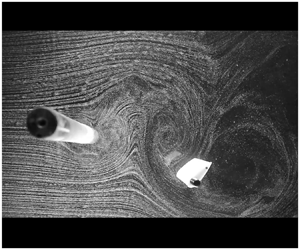Published online by Cambridge University Press: 02 August 2021

We present the dynamics of a hydrofoil free to oscillate in a plane as it interacts with vortices that are shed from a cylinder placed upstream. We consider cases where the cylinder is (i) fixed, (ii) forced to rotate constantly in one direction or (iii) forced to rotate periodically. When the upstream cylinder is fixed, at lower reduced velocities, the hydrofoil oscillates with a frequency equal to the frequency of vortices shed from the cylinder, and at higher reduced velocities with a frequency equal to half of the shedding frequency. When we force the cylinder to rotate in one direction, we control its wake and directly influence the response of the hydrofoil. When the rotation rate goes beyond a critical value, the vortex shedding in the cylinder's wake is suppressed and the hydrofoil is moved to one side and remains mainly static. When we force the cylinder to rotate periodically, we control the frequency of vortex shedding, which will be equal to the rotation frequency. Then at lower rotation frequencies, the hydrofoil interacts with one of the vortices in its oscillation path in the positive crossflow (transverse) direction, and with the second vortex in the negative crossflow direction, resulting in a 2:1 ratio between its inline and crossflow oscillations and a figure-eight trajectory. At higher rotation frequencies, the hydrofoil interacts with both shed vortices on its positive crossflow path and again in its negative crossflow path, resulting in a 1:1 ratio between its inline and crossflow oscillations and a linear trajectory.
The interactions of the hydrofoil with the vortices in the wake of the fixed cylinder in a sample case of Region I